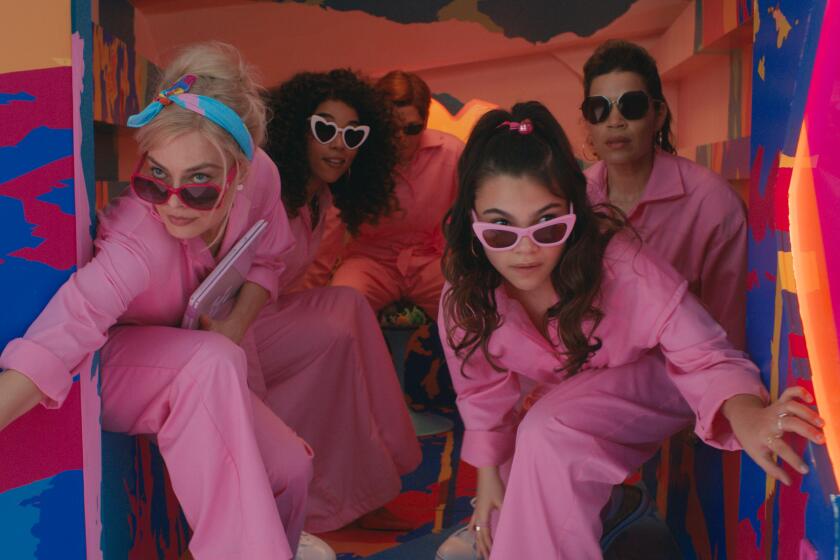Artists at odds over their role in narco culture
Edgar Quintero swears that he doesn’t really know any swaggering narco kingpins. He just impersonates them in his songs.
With his bandmates in the group BuKnas de Culiacan, Quintero fires up dance halls from El Paso to East L.A. packed with fist-pumping teenagers and twentysomethings. He’s a virtuoso of the narcocorrido genre, accordion-driven, blood-lusting ballads that lionize the exploits of Mexico’s brutal drug cartels and their bosses.
“With an AK-47 and a bazooka on my shoulder / Cross my path and I’ll chop your head off / We’re bloodthirsty, crazy and we like to kill,” goes one typically sanguinary tune. On stage, band members sport ski masks and carry fake AK-47s along with their instruments.
PHOTOS: Unexpected musical collaborations
As a principal subject of Shaul Schwarz’s harrowing new documentary, “Narco Cultura,” Quintero, who lives in Greater Los Angeles, where much of the narcocorrido industry is based, knows that some regard his shtick as cynical exploitation, particularly because many of his songs are written on commission and paid for by tough-looking guys with fat billfolds and opaque identities.
Yet Quintero views himself simply as a hard-working troubadour and family man giving his fans exactly what they want. He asserts that he and his fellow narcocorridistas don’t exacerbate Mexico’s rampant violence, they merely reflect it. “I’m not going to change the world if I start singing about peace and love,” he said, incongruously ensconced with Schwarz in the garden of the Four Seasons hotel.
As Mexico’s narco-related violence continues to grind on, filmmakers, playwrights, novelists and other artists struggle to find something new and insightful to say about a scourge that has lasted seven years and left an estimated 80,000 people dead. Some also are assessing their role as cultural agents and arbiters of the crisis.
“Narco Cultura” and Amat Escalante’s fictional feature “Heli,” which screened at last month’s AFI Festival, are among the latest attempts to explore how thoroughly the brutal conflict has seeped into Mexican society, contaminating not only the country’s politics but its economy, its family life, its landscapes, its very identity.
PHOTOS: Behind the scenes of movies and TV
Both films, along with Gerardo Naranjo’s “Miss Bala” (2011), a Kafka-esque parable about a would-be beauty queen caught up in a gang war, and Luis Estrada’s 2010 black comic satire “El Infierno” (Hell), about a man who returns to his mob-ruled Mexican hometown after two decades in the United States, convey a pervasive sense of hopelessness, despite assurances from President Enrique Peña Nieto that top capos are being arrested and progress is being made.
These serious-minded movies also face a challenge in attracting audiences who are saturated with daily imagery of bloodshed. Meanwhile, Mexico continues to churn out B-grade crime thrillers and sensationalistic telenovelas that revel in the chaos and carnage.
“There’s many movies that touch this subject,” Escalante said last month in Hollywood. “But Mexican people do say, ‘Oh, another movie about this.’ They feel uncomfortable with the subject.”
Besides widespread public skepticism that the bloodshed can be stopped, Mexican filmmakers must contend with another despairing aspect of the drug war: the perception that it has become increasingly difficult for ordinary people to distance themselves from the conflagration. In some remote parts of Mexico, terrorized citizens have banded together in makeshift militias in a last-ditch attempt to keep drug traffickers out.
In “Heli,” the title character is an unsuspecting 17-year-old boy, who is married with an infant son, and works at an auto-assembly plant. He inadvertently gets caught up in a web of murder and corruption when his sister becomes involved with a young army soldier who tries to sell stolen cocaine packages to pay for the couple’s elopement.
PHOTOS: Celebrities by The Times
Gradually at first, Heli (played by Armando Espitia) begins to behave more erratically and dangerously in response to the evil swirling around him. “He goes into the darkness of that world,” the director said. “He decides to take the law into his own hands, which is a feeling which is boiling up in Mexico.”
Filmed around Guanajuato, where Escalante lives, “Heli” subtly suggests that the culture of drug violence grows out of a matrix of deep-rooted structural problems: vast disparities in wealth, a corrupt and inept criminal justice system, rampant teen pregnancy, the haphazard flow of consumer goods and human migrants across international borders; and a globalized economy that treats low-wage workers as disposable, anonymous units.
“But more than anything,” Escalante said, “I think it’s the responsibility of the United States. It’s the No. 1 consumer of cocaine in the world, the United States, and the dealer is next door.”
Although the film never condescends to preach, it establishes a social and economic context for understanding the otherwise inexplicable savagery taking place. In that way, it echoes the arguments made by analysts such as Mexican journalist Sergio González Rodríguez, whose writings about the murders of hundreds of women in Ciudad Juárez are at last being translated into English.
PHOTOS: Billion-dollar movie club
The wave of Juárez murders has been attributed to such disparate causes as jealous boyfriends, serial killers, drug smuggling and snuff films, but what distinguishes the crimes there is also what allows the narco violence throughout Mexico to continue. González Rodríguez described it in his book “The Femicide Machine,” about the Juárez killings, as a culture of “judicial and political impunity,” “a law of complicity between criminals, police, military, government officials, and citizens who constitute an a-legal old-boy network.”
That’s similar to the perspective in Roberto Bolaño’s novel “2666,” which revolves around the Juárez killings and won the National Book Critics Circle Award in 2009. Although published in 2004, two years before Mexico’s drug violence began to soar, the monumental work by the late Chilean author reads as a hauntingly prescient vision of a country, if not an entire planet, that has lost its moral bearings.
It’s telling that González Rodríguez appears in “2666” as a semi-fictionalized Mexico City journalist. In his work, Bolaño frequently blurred fact with fiction, in keeping with his philosophy that art is a serious business that can’t be quarantined from ugly realities. Four principal characters in “2666” are young, self-absorbed academics pursuing a wild goose chase, stumbling into Juárez in search of an obscure lost writer. When art shirks its moral responsibilities, Bolaño suggests, it shares culpability for whatever follows.
Sitting at a Beverly Hills hotel on a sunny day, filmmaker Schwarz said he could see two sides to the question of how to treat controversial culture in perilous times.
“If I take a kid in Juarez who’s seeing his mom work at a maquiladora for $5 a day, and he hears Edgar’s songs, to some degree will that push him closer to being part of a cartel? Maybe,” he said.
“Entertainment has dealt with outlaws forever, from Tony Soprano to the never-ending list. Does the culture affect the reality? I think so. But reality creates the culture.”
More to Read
Only good movies
Get the Indie Focus newsletter, Mark Olsen's weekly guide to the world of cinema.
You may occasionally receive promotional content from the Los Angeles Times.











